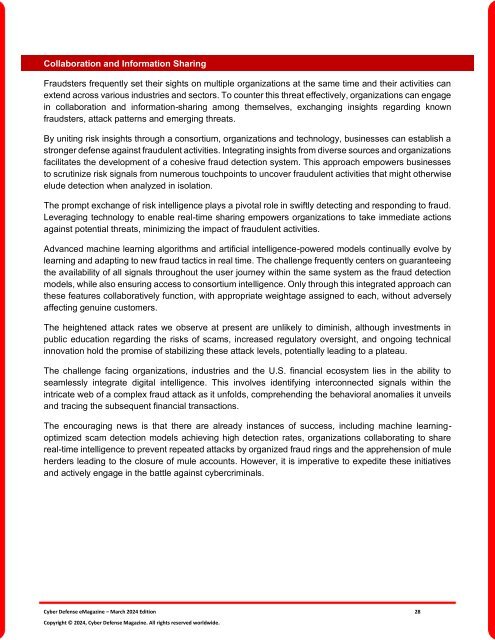The Cyber Defense eMagazine March Edition for 2024
Cyber Defense eMagazine March Edition for 2024 #CDM #CYBERDEFENSEMAG @CyberDefenseMag by @Miliefsky a world-renowned cyber security expert and the Publisher of Cyber Defense Magazine as part of the Cyber Defense Media Group as well as Yan Ross, Editor-in-Chief and many more writers, partners and supporters who make this an awesome publication! 225 page March Edition fully packed with some of our best content. Thank you all and to our readers! OSINT ROCKS! #CDM #CDMG #OSINT #CYBERSECURITY #INFOSEC #BEST #PRACTICES #TIPS #TECHNIQUES
Cyber Defense eMagazine March Edition for 2024 #CDM #CYBERDEFENSEMAG @CyberDefenseMag by @Miliefsky a world-renowned cyber security expert and the Publisher of Cyber Defense Magazine as part of the Cyber Defense Media Group as well as Yan Ross, Editor-in-Chief and many more writers, partners and supporters who make this an awesome publication! 225 page March Edition fully packed with some of our best content. Thank you all and to our readers! OSINT ROCKS! #CDM #CDMG #OSINT #CYBERSECURITY #INFOSEC #BEST #PRACTICES #TIPS #TECHNIQUES
Create successful ePaper yourself
Turn your PDF publications into a flip-book with our unique Google optimized e-Paper software.
Collaboration and In<strong>for</strong>mation Sharing<br />
Fraudsters frequently set their sights on multiple organizations at the same time and their activities can<br />
extend across various industries and sectors. To counter this threat effectively, organizations can engage<br />
in collaboration and in<strong>for</strong>mation-sharing among themselves, exchanging insights regarding known<br />
fraudsters, attack patterns and emerging threats.<br />
By uniting risk insights through a consortium, organizations and technology, businesses can establish a<br />
stronger defense against fraudulent activities. Integrating insights from diverse sources and organizations<br />
facilitates the development of a cohesive fraud detection system. This approach empowers businesses<br />
to scrutinize risk signals from numerous touchpoints to uncover fraudulent activities that might otherwise<br />
elude detection when analyzed in isolation.<br />
<strong>The</strong> prompt exchange of risk intelligence plays a pivotal role in swiftly detecting and responding to fraud.<br />
Leveraging technology to enable real-time sharing empowers organizations to take immediate actions<br />
against potential threats, minimizing the impact of fraudulent activities.<br />
Advanced machine learning algorithms and artificial intelligence-powered models continually evolve by<br />
learning and adapting to new fraud tactics in real time. <strong>The</strong> challenge frequently centers on guaranteeing<br />
the availability of all signals throughout the user journey within the same system as the fraud detection<br />
models, while also ensuring access to consortium intelligence. Only through this integrated approach can<br />
these features collaboratively function, with appropriate weightage assigned to each, without adversely<br />
affecting genuine customers.<br />
<strong>The</strong> heightened attack rates we observe at present are unlikely to diminish, although investments in<br />
public education regarding the risks of scams, increased regulatory oversight, and ongoing technical<br />
innovation hold the promise of stabilizing these attack levels, potentially leading to a plateau.<br />
<strong>The</strong> challenge facing organizations, industries and the U.S. financial ecosystem lies in the ability to<br />
seamlessly integrate digital intelligence. This involves identifying interconnected signals within the<br />
intricate web of a complex fraud attack as it unfolds, comprehending the behavioral anomalies it unveils<br />
and tracing the subsequent financial transactions.<br />
<strong>The</strong> encouraging news is that there are already instances of success, including machine learningoptimized<br />
scam detection models achieving high detection rates, organizations collaborating to share<br />
real-time intelligence to prevent repeated attacks by organized fraud rings and the apprehension of mule<br />
herders leading to the closure of mule accounts. However, it is imperative to expedite these initiatives<br />
and actively engage in the battle against cybercriminals.<br />
<strong>Cyber</strong> <strong>Defense</strong> <strong>eMagazine</strong> – <strong>March</strong> <strong>2024</strong> <strong>Edition</strong> 28<br />
Copyright © <strong>2024</strong>, <strong>Cyber</strong> <strong>Defense</strong> Magazine. All rights reserved worldwide.

















